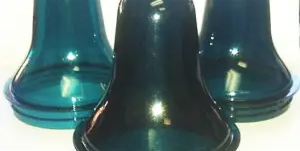
Visual differences of preforms
Can you see a visual difference between the three samples above? Chances are if you can see a difference between samples then HunterLab instruments can measure and quantify these variances. There are several ways to quantify differences with color measurement. You can evaluate dL* da* and db* values to see how samples vary from a standard within the L* a* b* color scale. There are also single number metrics that can be used to quantify color differences. Although dL* da* and db* values define color differences well a single number Pass/Fail measurement that defines a 3 dimensional tolerance can be helpful.
One of the most robust single number color quality metrics is dE CMC (also called delta E CMC.) dE CMC is an elliptical tolerance that was developed by the Color Measurement Committee of the Society of Dyers and Colorists. Color differences calculated using the CMC method are believed to correlate better with visual assessment than other color differences. The CMC ellipse is unique in that the shape of it changes depending on where the standard is in color space.
A dE CMC value of 1 represents an approximate visual difference for a very flat uniform surface, such as a tile. However, most sample types are not a uniform tile. What tolerances are acceptable varies depending on the application. Customers have to balance minimum perceptible differences with maximum acceptable differences in their products. The size of the dE CMC ellipse can be adjusted to the maximum acceptable limit by adjusting a factor in the CMC calculation.
In the samples above a clear visual difference can be observed. Our instruments were able to measure and quantify this difference. The product in the middle is the standard and the samples to the left and right represent unacceptable colors. The sample on the left measured a dE CMC value of approximately 19 and the sample on the left measured a dE CMC value of approximately 4. One of the major benefits of HunterLab instruments is that they are able to quantify color differences that are visually observed in products.

